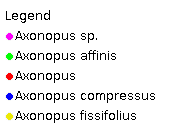Axonopus* P.Beauv.,. Ess. Agrostogr. 12 (1812).
Derivation:.
From Greek axon (axis) and pous (foot), derivation uncertain.
Key references
(keys and floras):. C.A.Gardner, Flora of Western Australia 1 Gramineae
237–238 (1952); E.E.Henty, Manual Grasses New Guinea 33 (1969);
M.Lazarides, Tropical Grasses S.E.Asia 106 (1980); J.C.Tothill and
J.B.Hacker, Grasses of Southern Queensland 124–125 (1983); R.D.Webster, Australian
Paniceae 13–15 (1987); B.K.Simon, Key to Australian Grasses 76
(1993); S.W.L.Jacobs and C.A.Wall, Flora of New South Wales 4: 463–464
(1993); N.G. Walsh, Flora of Victoria 2: 598–599 (1994); E.Edgar and
H.E.Connor, Flora of New Zealand 5: 536–537 (2000); D.Sharp and
B.K.Simon, AusGrass (2002); J.P.Jessop, Grasses of South Australia 425
(2006); S.W.L.Jacobs, R.D.B.Whalley & D.J.B.Wheeler, Grasses of New
South Wales, 4th Ed, 164–165 (2008).
W.D.Clayton &
S.A.Renvoize, Genera Graminum (1986), genus (500).
Naturalised. 114
species, from tropical South America. 2 species in Australia, WA, NT, SA, Qld,
NSW, and Vic. Also New Guinea, Malesia and New Zealand.
Habit. Annual
(rarely) or perennial, stoloniferous (sometimes mat-forming) or tufted. Leaf
blades broad or narrow. Ligule an unfringed membrane.
Inflorescence.
Inflorescence of spicate main branches, of digitate or subdigitate racemes or
spikes, digitate (rarely) or non-digitate.
Spikelets.
Spikelets all partially embedded in rachis (all placed on one side of rachis),
dorsally compressed, 2 flowered, with 1 fertile floret, solitary. Fertile
spikelets with lower incomplete floret(s), oblong or elliptic or lanceolate or
ovate or obovate, adaxial (with lower glume against rachis), falling with
glumes.
Glumes. Glumes
one per spikelet (membranous), long relative to adjacent lemmas, awnless. Upper
glume 4–5 nerved.
Florets. Lower
incomplete floret(s) sterile. Lemmas awnless, 0 nerved or 2 nerved (the median
lacking), slightly exceeding fertile lemmas (and equal in length to upper
glume), less firm than fertile lemmas (membranous), not becoming indurated.
Fertile florets 1. Lemmas decidedly firmer than glumes, smooth to striate,
becoming indurated to not becoming indurated (papery to crustaceous), yellow in
fruit or brown in fruit, entire at apex, blunt, muticous, with a clear
germination flap, 4 nerved, glabrous, having margins tucked into palea. Palea
relatively long, entire, textured like lemma, indurated or not indurated.
Lodicules 2. Stamens 3. Grain small, ellipsoid, compressed dorsiventrally.
Hilum short. Embryo large.
Kranz Anatomy.
C4, biochemical type NADP-ME (1 species).
2n = 20,
40, 60, and 80, 2, 4, 6, and 8 ploid, commonly adventive.
Habitat.
Helophytic to mesophytic. Savanna, forest clearings, moist and weedy places.
Species of open habitats.
Classification.
Panicoideae; Paniceae.
Notes.
Inflorescence and vegetative characters are remarkably uniform and the genus is
easy to recognise, but these factors aslo make it taxonomically difficult, for
the difference between its many species are slight (Clayton and Renvoize,
1986).
Types Species. A.
compressus (Sw.) P.Beauv.
Biogeographic
Element. Clifford & Simon 1981, Simon & Jacobs 1990: Naturalised.


